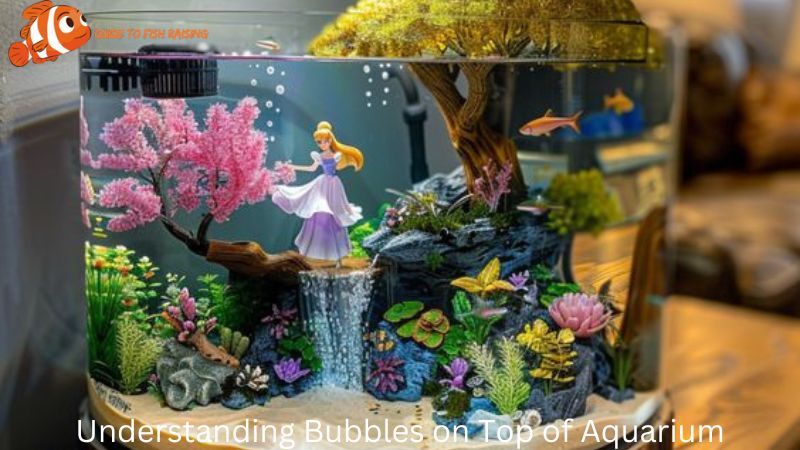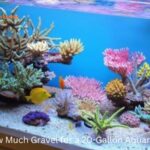Aquariums are a beautiful addition to any home, bringing a slice of aquatic life into our living spaces. However, maintaining an aquarium can come with its set of challenges. One common issue that many aquarium owners encounter is the presence of bubbles on top of aquarium.
Understanding the causes, implications, and solutions for these bubbles is crucial for maintaining a healthy aquarium environment. This article Guide to Fish Raising will delve into the various aspects of bubbles on top of aquarium, including their origins, effects on tank inhabitants, and effective management strategies.
Table of contents
ToggleCauses of Bubbles on Top of Aquarium
Bubbles on the surface of aquarium water can arise from several sources. Identifying the root cause is the first step toward addressing the issue effectively. Here are the primary factors that can lead to bubble formation in an aquarium:
Aeration and Filtration Systems
Aquarium aeration and filtration systems are essential for introducing oxygen into the water and maintaining water clarity. However, these systems can also create bubbles as air is pumped through the water.
- Air Stones and Bubblers: These are common aeration devices that produce fine bubbles to oxygenate the water. While typically beneficial, an excess of these bubbles can accumulate on the surface if the air stones and bubblers are overactive or improperly placed.
- Filter Output: Filters with high output rates can cause significant water surface agitation, leading to bubble formation. This is especially true for filters designed to create strong water currents, which can churn the water and trap air, creating surface bubbles.
Protein Accumulation
Proteins and organic waste in the aquarium are another common source of bubble formation.
- Protein Skimmers: In saltwater aquariums, protein skimmers are used to remove dissolved organic compounds from the water. The skimming process inherently creates bubbles as it separates proteins and waste, which can sometimes accumulate on the surface.
- Organic Waste: In freshwater aquariums, the accumulation of organic waste such as fish excrement, uneaten food, and decaying plant matter can lead to protein build-up. This build-up can create a protein film on the water surface, leading to bubble formation.
Chemical Imbalances
Chemical imbalances within the aquarium water can also result in bubble formation.
- Water Conditioner: Using water conditioners, especially those designed to detoxify heavy metals and chlorine, can cause temporary bubbling. These conditioners often react with the water, creating a foamy surface as they neutralize harmful substances.
- Medications and Treatments: Certain medications and treatments added to the aquarium water can alter its chemical composition. These changes can sometimes result in the production of bubbles, especially if the chemicals react with organic compounds or alter the water’s surface tension.
Surface Agitation
Surface agitation from various sources can directly create bubbles.
- Fish Activity: Active fish swimming near the surface can disturb the water, causing bubbles to form. Surface-dwelling fish or those that frequently dart to the surface can contribute significantly to surface agitation.
- Water Changes: Pouring new water into the aquarium during water changes can introduce air into the tank, causing bubbles to form on the surface. This is particularly noticeable if the water is added too quickly or poured from a height, trapping more air in the process.
Effects of Bubbles on Aquarium Inhabitants
Bubbles on the water surface in an aquarium can have various implications for the health and well-being of the aquatic inhabitants. While some bubbles are beneficial, indicating proper aeration, others can signal underlying problems that may affect the overall health of the tank environment.
Oxygen Levels
Bubbles produced by aeration systems generally play a positive role in increasing oxygen levels in the water. Proper aeration ensures that sufficient oxygen is available for fish and other aquatic organisms, which is crucial for their respiration and overall health.
Aeration systems, such as air stones and bubblers, are designed to enhance oxygen exchange and contribute to a stable and healthy environment. However, excessive bubbles can indicate over-aeration, which might lead to stress for fish and other tank inhabitants.
Over-aeration can disrupt the tank’s natural equilibrium, potentially causing undue stress or discomfort for the fish, especially if it results in excessive water movement or noise.
Water Quality
Bubbles caused by protein accumulation or chemical imbalances can signal underlying water quality issues that may impact the health of the aquarium’s inhabitants.
Persistent bubbles forming a protein film on the water surface can impede gas exchange and reduce oxygenation, which is detrimental to aquatic life. This protein film can also trap heat and affect temperature stability, further stressing fish and other organisms.
Additionally, bubbles resulting from chemical treatments can indicate changes in the water’s chemical balance. If these treatments alter the pH or introduce toxins, they can cause stress or harm to fish, leading to symptoms such as erratic behavior, respiratory issues, or weakened immune systems.
Aesthetic Concerns
While bubbles may not directly harm the inhabitants, they can affect the aesthetic appeal of the aquarium. Excessive bubbles can obscure the view of the tank, detracting from its visual appeal and making it harder to observe the fish and other elements of the tank.
This can be particularly bothersome for aquarium enthusiasts who take pride in the appearance of their aquatic setup. Additionally, bubbles can give the appearance of a dirty or poorly maintained tank, even if the water quality is actually good.
This can affect the perception of the tank’s cleanliness and overall maintenance, potentially impacting the enjoyment and pride of the aquarium keeper.
Managing and Preventing Bubbles

Effectively managing and preventing bubbles on the aquarium surface involves addressing their root causes and implementing proactive measures. This requires a holistic approach, focusing on aeration and filtration adjustments, reducing protein accumulation, monitoring chemical levels, and managing surface agitation.
Adjusting Aeration and Filtration
Balancing aeration and filtration is crucial in reducing bubble formation in an aquarium. Proper placement of air stones and bubblers is essential; they should be positioned deeper in the tank to allow bubbles to dissipate before reaching the surface. This minimizes surface agitation, which is a common cause of bubble formation.
Additionally, adjusting the flow rate of filters can significantly reduce surface agitation. Using spray bars or diffusers helps distribute water flow more evenly, preventing localized turbulence that can introduce excess air into the water. Ensuring that the filtration system is appropriately sized for the tank and properly maintained is also vital in maintaining a balanced aquatic environment.
Reducing Protein Accumulation
Protein build-up in the aquarium can lead to foam and bubbles on the water surface. Maintaining a clean tank environment is key to minimizing protein accumulation. Regular maintenance, such as weekly water changes of 10-20% and substrate vacuuming, helps remove organic waste that contributes to protein build-up.
In saltwater tanks, a properly functioning protein skimmer is essential. Ensure that the skimmer is appropriately sized for your tank and routinely check its performance. Managing the diet of your fish is also crucial; overfeeding can lead to excess food decomposing in the tank, contributing to protein accumulation. Feed your fish the appropriate amount and remove any uneaten food promptly to maintain water quality.
Monitoring Chemical Levels
Keeping water chemistry balanced is crucial for preventing bubbles caused by chemical imbalances. Regularly testing water parameters such as pH, ammonia, nitrite, and nitrate levels is essential. Maintaining these parameters within the recommended ranges for your specific tank inhabitants ensures a healthy environment and reduces the likelihood of bubble formation due to chemical reactions.
Careful use of treatments and medications is also important. Follow the directions on water conditioners and medications, and be mindful of their potential to cause temporary bubbling. Avoid overdosing and ensure that all chemical treatments are necessary and beneficial for your tank.
Managing Surface Agitation
Reducing unnecessary surface agitation can help minimize bubble formation. When performing water changes, pour new water slowly to reduce the introduction of air into the tank. This gradual approach prevents the creation of bubbles and foam on the water surface. Additionally, monitor the behavior of surface-dwelling fish.
Fish that frequently disturb the water surface can contribute to increased surface agitation and bubble formation. Ensuring that your fish have adequate space and are not stressed or overly active at the surface can help maintain a calm water surface.
Special Considerations for Different Tank Types
Different types of aquariums may have unique challenges when it comes to managing bubbles.
Freshwater Aquariums
Freshwater tanks typically face issues related to organic waste and over-aeration.
- Plant Considerations: Live plants can help absorb excess nutrients and reduce organic waste. Ensure plants are healthy and not contributing to debris.
- Filtration Balance: Choose a filter appropriate for the tank size and stock level. Overpowered filters can cause excessive surface agitation.
Saltwater Aquariums
Saltwater tanks, especially reef tanks, have additional considerations such as protein skimmers and complex water chemistry.
- Protein Skimmers: Regularly clean and maintain protein skimmers to prevent bubble overflow.
- Water Chemistry: Carefully monitor salinity, calcium, and alkalinity levels. Imbalances can exacerbate bubble formation.
Nano Aquariums
Small tanks have limited space for equipment and are more prone to water quality fluctuations.
- Compact Equipment: Use compact, efficient equipment designed for nano tanks to avoid excessive surface agitation.
- Frequent Maintenance: Perform more frequent water changes and maintenance to manage waste buildup and prevent bubbles.
Troubleshooting Persistent Bubble Issues
Persistent bubble issues in an aquarium can be frustrating and may indicate underlying problems that need to be addressed. By taking a systematic approach to troubleshooting, you can identify and resolve the root causes of these bubbles to ensure a healthy environment for your aquatic life.
Equipment Check
First and foremost, inspect all equipment for potential malfunctions or improper setup. Start with leak detection, as air leaks in tubing and connections can introduce excess air into the system, resulting in persistent bubbles. Carefully examine all hoses, seals, and fittings for any signs of wear or damage. Using a soapy water solution can help detect leaks; apply it to the connections and look for bubbles forming, which indicate a leak.
Additionally, ensure that all equipment is correctly installed and positioned. Verify that air pumps, filters, and heaters are functioning properly and not contributing to the introduction of excess air. Regular maintenance is crucial; clean filters, pumps, and other equipment regularly to prevent buildup that can lead to malfunctions.
Water Quality Assessment
Water quality plays a significant role in the formation of bubbles. Conduct a comprehensive water test to assess all key parameters, including ammonia, nitrite, nitrate, pH, phosphate, and silicate levels.
High levels of phosphates and silicates can contribute to bubble formation, so it’s essential to monitor these closely. Utilize high-quality test kits for accurate results, or consider professional testing services. Based on the results, make necessary adjustments; for instance, use phosphate removers or silicate-absorbing media if levels are high.
The quality of the water source is also critical. Tap water often contains dissolved gases and impurities that can lead to bubbles. Using a reverse osmosis (RO) unit can significantly improve water quality by removing these contaminants. Ensure that tap water is properly dechlorinated before adding it to the tank, as chlorine and chloramine can also cause bubbles.
Environmental Factors
The environment where the aquarium is located can affect bubble formation. Monitor the room conditions, particularly humidity and temperature. High humidity or significant temperature fluctuations can impact water chemistry and contribute to bubbles. If the room’s humidity is consistently high, using a dehumidifier can help stabilize conditions.
The location of the tank is also important; ensure it is placed in a stable environment away from direct sunlight, which can cause temperature swings. Avoid positioning the tank near windows or heating and cooling vents that can create drafts and temperature changes. Evaluate the water movement within the tank as well.
Excessive agitation from filters and pumps can introduce more air into the water, leading to bubble formation. Adjust the flow rate and direction to minimize surface agitation if necessary.
Conclusion
Bubbles on top of an aquarium can be more than just a minor annoyance; they can indicate underlying issues that need attention. By understanding the causes of bubble formation, assessing their effects on aquarium inhabitants, and implementing effective management strategies, you can ensure a healthy and visually appealing aquarium environment.
Regular maintenance, careful monitoring, and a proactive approach to problem-solving will help keep your aquarium free of unwanted bubbles and thriving with life. Whether you have a freshwater, saltwater, or nano aquarium, addressing bubble issues promptly and efficiently will contribute to the overall success of your aquatic ecosystem.





